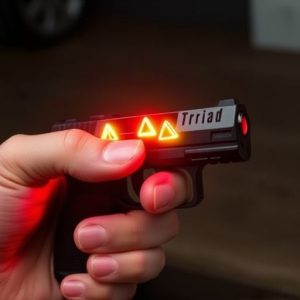Triad Stun Gun: Understanding Muscle Incapacitation Duration and Legal Implications
The Triad Stun Gun is a non-lethal weapon that temporarily disables individuals by disrupting nerve…….
The Triad Stun Gun is a non-lethal weapon that temporarily disables individuals by disrupting nerve system control over muscles, causing rapid spasms and unconsciousness for several minutes. Its unique triple-pronged design allows for quicker neutralization compared to single-probe models, making it popular among law enforcement and personal defense users. Effectiveness varies based on power output, target's physical characteristics, environmental conditions, and individual variables. With potential legal ramifications, proper training is crucial to maximize knockdown time while minimizing secondary injuries.
In today’s world, understanding the effects of stun guns on muscle incapacitation is crucial. This comprehensive guide explores the duration and factors influencing muscle disruption from stun guns, focusing specifically on the Triad Stun Gun and its design. We delve into the science behind non-lethal force, analyzing legal considerations and the impact on response times. Additionally, we offer strategies for optimizing stun gun training to ensure effective muscle incapacitation.
- Understanding Muscle Incapacitation: What Happens When Stun Guns Are Used?
- The Triad Stun Gun: Design and Effectiveness
- Factors Influencing Incapacity Duration: A Comprehensive Analysis
- Legal Considerations: Stun Gun Use and Its Impact on Response Times
- Optimizing Stun Gun Training: Strategies for Effective Muscle Disabilitation
Understanding Muscle Incapacitation: What Happens When Stun Guns Are Used?
When a triad stun gun is deployed, it aims to temporarily disable an individual through muscle incapacitation. This non-lethal weapon delivers an electric current that disrupts the nervous system’s control over muscles, causing them to spasm and relax rapidly. The rapid discharge of electricity interrupts communication between the brain and the muscles, leading to a brief period of paralysis or confusion in the target.
The duration of muscle incapacitation varies based on several factors, including the stun gun’s power output, the area targeted, and the individual’s physical condition. In general, a triad stun gun can render a person unconscious or severely disoriented for several minutes. This temporary incapacitation allows law enforcement or security personnel to control and subdue the target safely until backup arrives or the situation is resolved.
The Triad Stun Gun: Design and Effectiveness
The Triad Stun Gun stands out in the world of non-lethal self-defense tools with its unique design and potent effectiveness. This stun gun differs from traditional models by deploying three distinct prongs or probes that simultaneously target nerve endings, causing muscle incapacitation. Its innovative approach ensures a more comprehensive shock to the body, leading to quicker neutralization compared to single-probe devices.
This triple-action mechanism is particularly effective in close-quarters encounters where speed and accuracy are paramount. The stun gun’s design allows for a higher success rate by overwhelming the nervous system, resulting in temporary muscle paralysis. This enables users to gain critical time or escape potentially dangerous situations, making it a popular choice among law enforcement agencies and individuals seeking robust personal defense solutions.
Factors Influencing Incapacity Duration: A Comprehensive Analysis
The duration of muscle incapacitation caused by a stun gun can vary significantly and is influenced by several key factors. One of the primary considerations is the power output and design of the device, with higher voltage and advanced triad stun guns capable of prolonging the effect. The target’s physical attributes, including body mass, muscularity, and overall fitness level, play a crucial role in determining how long they remain incapacitated. For instance, individuals with higher muscle mass might experience shorter durations due to their larger nerve fiber density, which can dissipate the electrical impulse faster.
Environmental conditions also contribute to variability. Extreme temperatures, both hot and cold, can affect nerve conduction and muscle response, potentially altering the incapacitation duration. Additionally, factors like stress levels, previous exposure to similar devices, and individual pain thresholds can impact a person’s ability to recover quickly from the effects of a stun gun. Understanding these variables is essential for law enforcement and individuals seeking self-defense options, as it allows them to make informed decisions when choosing the appropriate triad stun gun for their specific needs.
Legal Considerations: Stun Gun Use and Its Impact on Response Times
The use of stun guns, or electroshock weapons, is a controversial topic with significant legal implications. When it comes to law enforcement and personal defense, understanding the duration of muscle incapacitation from stun guns is crucial. In many jurisdictions, stun guns are classified as less-lethal weapons, offering an alternative to traditional firearms for situations requiring immediate intervention. However, the effectiveness and legality of their use can vary widely.
One key consideration is response time. Stun guns are designed to disrupt muscle control, causing the target to experience a temporary paralyzing effect. Studies suggest that this incapacitation typically lasts from 2 to 15 seconds, depending on various factors such as the stun gun’s power output and the target’s physical condition. Legal experts argue that this brief window of vulnerability can be critical for officers to secure the scene or for individuals to escape harm. Yet, some advocate for stricter regulations, especially regarding the use of high-power triad stun guns, to ensure responsible deployment and mitigate potential injuries or civil liberties concerns.
Optimizing Stun Gun Training: Strategies for Effective Muscle Disabilitation
Optimizing Stun Gun Training is crucial for law enforcement and self-defense professionals to ensure they can effectively utilize this tool in high-pressure situations. The duration of muscle incapacitation from a stun gun, such as those using triad stun gun technology, varies based on factors like the device’s power output, the target’s body type, and their resistance to the shock. Training should focus on maximizing the average knockdown time while minimizing the risk of secondary injuries. Professionals can achieve this by practicing proper application techniques, understanding different stun gun settings, and simulating real-world scenarios with varying physical builds and defensive positions.
Regular drills that emphasize quick deployment and accurate targeting are essential. Additionally, training sessions should incorporate debriefs to analyze performance and refine strategies. The use of advanced triad stun guns allows for more precise muscle control, enabling officers to disable suspects effectively while reducing the likelihood of serious injuries. Therefore, continuous training ensures that users can make split-second decisions, adapt to dynamic environments, and consistently achieve optimal muscle incapacitation durations during critical incidents.
In light of the above discussions, it’s clear that understanding muscle incapacitation from stun guns, particularly the effectiveness of the Triad Stun Gun, is paramount. Comprehensive analysis of influencing factors and legal considerations further underscore the importance of strategic training for optimal use. By optimizing stun gun training, law enforcement and security personnel can enhance their ability to disable subjects efficiently while mitigating potential risks. This ensures swift response times and public safety in various scenarios.


